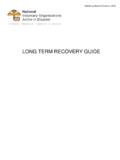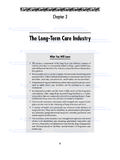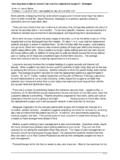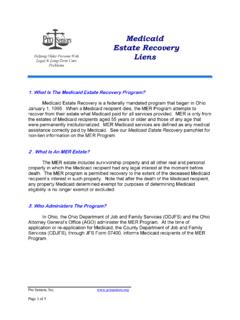Transcription of Alcoholics Anonymous (AA) Recovery Outcome Rates
1 Alcoholics Anonymous (AA) Recovery Outcome Rates Contemporary Myth and Misinterpretation January 1, 2008 Updated with 2007 Survey Results October 11, 2008 AA Recovery Outcome Rates - Contemporary Myth and Misinterpretation Version Updated 1 10/11/2008 Introduction .. 1 Foreword .. 2 a) Triennial Surveys of AA Membership .. 4 AA Membership Survey Pamphlets (P-48) Published .. 4 Using Length of Sobriety as a Measurement of Success .. 5 b) First Year 6 Figure C-1 from the 1990 Summary Report of 1977-89 AA Triennial Membership Surveys .. 6 Figure C-1 Average of 5 Surveys.
2 7 Chart 1: 1st Year Retention per Summary of 1977-89 Surveys .. 9 Table 1: 1st Year Retention Percentages .. 9 c) Growth of Long-Term Sobriety .. 11 Chart 2: Growth of Long Term Sobriety Ranges .. 12 Table 2: Long Term Sobriety Ranges Percentages .. 12 Chart 3: Growth of Long Term Sobriety Averages .. 13 Table 3: Long Term Sobriety Averages .. 13 d) Timeline of Sources and Citations of AA s 50% + 25% Success Rates .. 14 e) Assessment of Claims of AA Success or Failures and Corroboration .. 21 Assessment of Claims of AA Success: .. 22 Assessment of Claims of AA Failure.
3 22 Assessment of Claims of Corroboration and Citations: .. 23 Assessment of Claims of Success in this paper: .. 24 f) Prescreening In Early AA .. 25 g) AA Membership Composition and Growth Trend .. 29 Table 4: AA Membership Growth Trend .. 30 Table 5: Estimated Counts of AA Groups and Members .. 31 Introduction This paper is written for AA members and is intended for internal and public circulation as an item of AA historical and archival research. It is offered to help inform the AA membership and academic researchers of a widely circulated misinterpretation and mischaracterization of AA Recovery outcomes.
4 The fellowship of Alcoholics Anonymous , as a matter of long established principle, policy and practice, does not engage in public debate and seeks to avoid public controversy. The authors of this paper must emphasize that we do not speak for AA. We have a personal interest in the history of AA and consider it imperative to correct historical inaccuracies and propagation of myth. Arthur S, Arlington, TX Tom E, Wappingers Falls, NY Glenn C, South Bend, IN The publication of this paper does not imply affiliation with, approval by, or endorsement from, Alcoholics Anonymous or any part of its worldwide organization and service structure.
5 The views expressed in this paper are solely those of the authors. AA, Alcoholics Anonymous , The Big Book, Box 4-5-9, The Grapevine, GV, Box 1980 and La Vi a are registered trademarks of Alcoholics Anonymous World Service (AAWS), Inc and AA Grapevine Inc. Single-use excerpts from AAWS and AA Grapevine publications are cited in this paper under the good faith and fair use provisions of US copyright statutes for purposes of criticism, comment, scholarship and research. AA Recovery Outcome Rates - Contemporary Myth and Misinterpretation Version Updated 2 10/11/2008 Foreword Nothing is more responsible for the good old days than a bad memory - Franklin P Adams (1881-1960) This paper addresses an erroneous myth that AA is experiencing a 5% (or less) success rate today as opposed to either a 50%, 70%, 75%, 80% or 93% (take your pick) success rate it once reputedly enjoyed in the 1940s and 1950s.
6 The term myth is used to emphasize that the low success Rates promulgated are a product of imagination, invention and inattention to detail rather than fact-based research. Also noteworthy in the derivation of the mythical percentages, is the absence of fundamental academic disciplines of methodical research, corroborating verification and factual citation of sources. Regrettably, some of the advocates who are propagating the myth are AA members who purport to be AA Historians and appear to be advocating agendas that portray fiction as fact and hearsay as history.
7 The AA Fellowship has a robust verbal tradition. Much information is passed on by word of mouth. This has both its good and difficult sides. How does one know what is fact versus myth? AA members can sincerely state something they believe is true but is inaccurate - this is the difference between myth and fact. Consequently, much effort has been taken to ensure that the contents of this paper are independently confirmed in reliable written reference sources. Those sources are identified in footnotes or in the body of the narrative. References have been made on the internet, in publications, in individual AA talks and on TV, that depict AA s early to mid years, as having had a typical successful Recovery rate Outcome of 50-75%.
8 These high-end numbers are often followed by a second depiction that contemporary AA has deteriorated to a 10% or 5% or less Recovery rate Outcome . The two sets of numbers (high versus low percentage) are then cast in an idyllic portrayal of past AA contrasted to a dismal scenario of AA today. Claims of a 10%, 5% or less success rate for contemporary AA are erroneous and rest largely and misguidedly on the misinterpretation of data in a 1989-1990 internal AA General Service Office 1 report on AA Triennial Membership Surveys.
9 The assertion of a 50-75% success rate in AA is derived from various AA literature sources and other written sources, but is not explicitly demonstrated except in one instance. That instance pertains to the AA members who had their personal stories printed in the first edition Big Book. 2 The 50-75% success rate number has been cited, without change or challenge, since it first publicly appeared in 1941 and it persists to this date. In 1989-1990, an internal General Service Office (GSO) report, analyzing 5 prior AA membership surveys, contained a hand-written graph that has been persistently misconstrued to attempt to portray AA s success rate as 5% or less (or AA s failure rate as some cast it, of 95% or more).
10 3 The graph has been cited as representing retention or success Rates when in fact it simply illustrates the distribution of the length of time the population participating in the survey sample have been attending AA. Other survey questions asked about sobriety. This was only about attendance in the first year after someone s first meeting. It is astonishing that negative projections of AA of such magnitude are casually issued with presumed certainty but contain no demonstration of where or when the certainty had been established.






